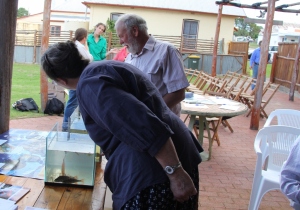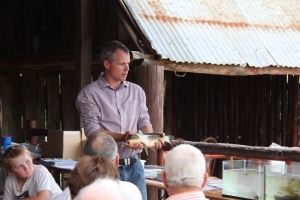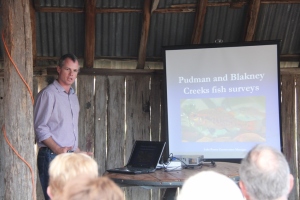
About 40 local landowners and interested Landcarers and LLS staff came to hear the results of the monitoring and breeding program of the Yellow Spotted Bell Frog and Southern Pygmy Perch in the Blakney Creek area at the Royal Hotel in Dalton in early March.
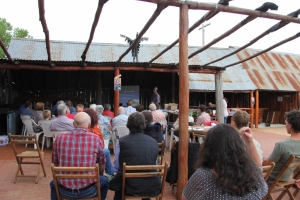
Blakney Creek has been identified as a hot spot for endangered aquatic species in the Lachlan catchment.
Threatened / endangered species including Southern Pygmy Perch and Macquarie Perch cohabit in the sub-catchment with the recently found Yellow Spotted Bell Frog (not previously seen in the wild for 30 years).
The former Lachlan CMA have been running a project since 2012 in the Blakney Creek area- “Fish, Frogs and Hollow Logs” in partnership with Department of Primary Industries (DPI) Office of Environment and Heritage (OEH), Taronga Zoo and local Landholders, which aims to protect and restore critical habitat associated with the threatened species. It also aims to increase landholder awareness of the threatened species and monitor the threatened populations.
Many Landholders in the Blakney Creek area have become involved in the project doing on-ground works such as riparian revegetation with direct seeding and tubestock; undertaking measures such as fencing and under storey enhancement to protect existing remnants; removing stock from streams and using alternative watering points. Over the next few months there are plans for invasive species control program – Feral Fox Fighters- with the aim of protecting the endangered aquatic species.
Luke Pearce – (Conservation manager- Department of Primary Industries) gave an excellent presentation on the southern pygmy perch (SPP) (presentation available here Southern Pygmy Perch )with the reasons for their decline; modification of natural river flows; reduced floodplain and wetland inundation; thermal pollution; water extraction; predation; competition and disease from introduced species (Red Fin Perch; Carp); degradation of the riparian zone; loss of aquatic plants; water quality decline; erosion and sedimentation.
Luke gave a demonstration of the equipment that he uses when doing the monitoring of SPP.
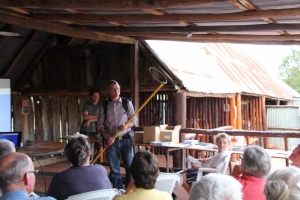
To find out more about what fish recovery projects are happening there is a special edition of Ecological Management and Restoration all about Bringing back native fish out this month click on link below to view online:
David Hunter – Threatened Species officer with OEH has been involved in the “Fish Frogs and Hollow Logs” project at Blakney Creek after the Yellow spotted Bell frog YSBF was discovered there (not seen for 30 years) by Luke Pearce in 2010 (see article SMH).
Unfortunately the local YSBF populations seem to have been decreasing over the monitoring period (2010-2014). The major reasons for decline in frog populations are disease- specifically, Chytridiomycosis a disease caused by infection with the Amphibian Chytrid Fungus (Batrachochytrium dendrobatidis) and habitat degradation. The presentation on the YSBF is available here: YSBF_Dalton14
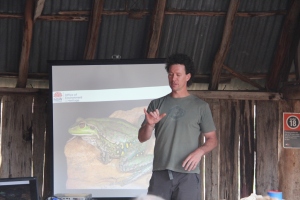
Dr Hunter explains that there are ways that we can build resilience into our biodiversity that gives them greater ability to deal with these threats.
There are too categories, things that we can manage now and things we cant manage now. If we manage adequately the things that we can manage it alleviates the pressure at a population level and can often allow things to be more resilient to threats that we cant manage.
In terms of habitat degradation the more habitat, the more connected the habitat and better quality our habitat is the greater the possibility that animals will have a place of refuge during extreme drought events or whatever the climatic event might be.
Dr Hunter also acknowledged that there is a lot of area in the district which has not been surveyed for the YSBF and there could be populations out there. The reason why is was discovered in the first place was that someone who knew about it was working in the area and when knew what he was looking at. Now that we all have this knowledge about the YSBF if we think we see one then we can contact him or Damon Oliver so they can come out and have a look and we may just find more populations of this important frog.
The Taronga Zoo has become involved in the project setting up a breeding program for the Yellow Spotted Bell Frog. Notes from this presentation are available here: Castanea zoo talk – Dalton
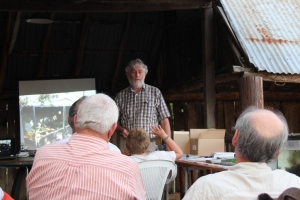
Damon Oliver from OEH also gave a plug about the Superb Parrot monitoring which he is involved with. We will hopefully have an opportunity to get involved with this project in the future as well. More info available here: Superb_Parrot_Community_Monitoring_Sep_2013

